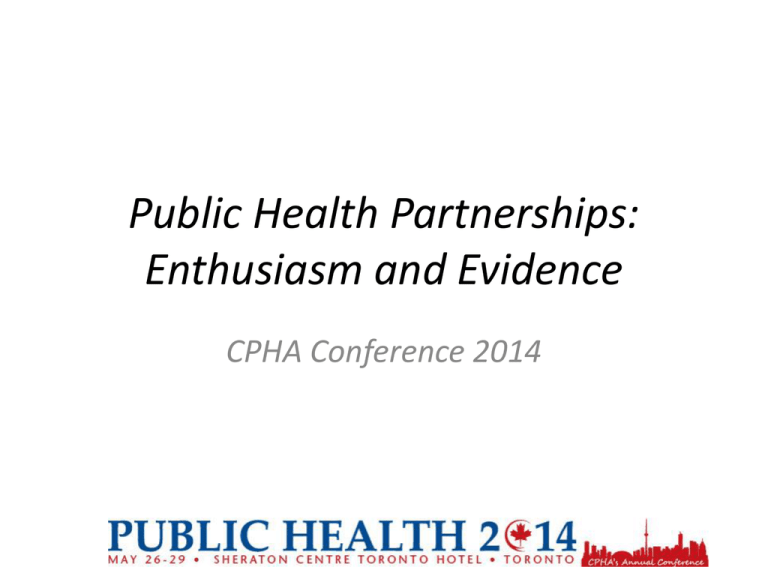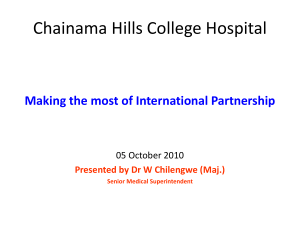Presentation - Canadian Public Health Association
advertisement

Public Health Partnerships: Enthusiasm and Evidence CPHA Conference 2014 Presenters • Ross Graham – Manager of Strategic Projects, Middlesex-London Health Unit • Shannon Sibbald – Assistant Professor, Faculty of Health Sciences & Schulich Interfaculty Program in Public Health, Western University • Anita Kothari – Associate Professor, Faculty of Health Sciences, Western University Learning Objectives • Describe the conflicting evidence and enthusiasm for public health partnerships • Explore tools to support effective decisionmaking regarding partnerships • Define strategies to optimize knowledge translation and service delivery via partnerships Format • • • • Hands up Questions Questions and discussion throughout Questions at the end Time for panel questions at the end Public Health Partnerships: Enthusiasm & Evidence Ross Graham MSc CHE Manager, Strategic Projects Middlesex-London Health Unit ross.graham@mlhu.on.ca “collaboration in public health… is not an option – it is necessary for success”(Wise, 2008) PHPs in your Organization? What areas of your organization commonly use PHPs? 1. Not commonly used 2. Commonly used, but mostly in health promotion areas 3. Commonly used, but mostly in protection/prevention areas 4. Commonly used across all areas Roughly, how many PHPs is your organization involved with? 1. 0 to 50 2. 51 to 100 3. 100 to 200 4. >200 Not Optional • A Core Competencies Canadian Public Health Practitioners (#4) • A Foundation of the Ontario PH Standards – And Mentioned ~10,000 times in the OPHS • A Requirement for Ontario Health Organizations (#5.2) And Internationally, • A core/essential/foundational PH practice (US, UK, Australia) • A top PHSSR priority (in Canada too!) However… Partnerships are “perhaps the greatest challenge of the field” given public health’s “non-hierarchal structure involving seemingly limitless numbers of stakeholders”(Koh, 2009) “the sheer variety of partnerships can be bewildering… possibly nowhere more so than in public health”(Hunter & Perkins, 2012) What does the evidence say? Not Quite As Enthusiastic… • “many studies, perhaps wrongly in some cases, equate the presence of collaboration with the success of a program without adequate empirical verification.”(McGuire, 2006) • “despite a common belief that multisector collaboration can improve population health, researchers seldom study the effect of such collaboration on population health outcomes.”(Woulfe et al., 2010) • partnerships still driven by ‘conventional wisdom’ rather than evidence. (Woulfe et al., 2010) • only 30% of PHPs demonstrated “improved population-level outcomes that might be attributed to collaboration activities.”(Roussos & Fawcett, 2000). Not Quite As Enthusiastic… • “little evidence of the direct health effects of public health partnerships”(Smith et al., 2009) • “where successes relating to public health outcomes were observed, it was extremely difficult to assess the extent to which these were directly attributable to partnership working.”(Smith et al., 2009) • From the incl. review (Smith et al.) “the impacts of intersectoral action on health equity are mixed and limited” (NCCMT, 2012) • “Collaboration between local health and local government is commonly considered best practice. However, the review did not identify any reliable evidence that inter-agency collaboration, compared to standard services, leads to health improvement” (Cochrane Review, 2011). PHPs can be effective & necessary PHPs Appear most effective at • fostering knowledge exchange (between practitioners and organizations) • facilitating community-based research • achieving moderate behaviour-change in targeted populations • supporting provision of PH services when PH agencies have minimal resources But Remember: Effective PHPs are the exception, not the rule The Bottom Line • Mismatched enthusiasm & evidence – Well-documented romance of collaboration • Tough scenario for PH practitioners • Need to – Discuss partnerships realistically – View partnerships as tool in PH toolbox – Build the evidence base Recommendations 1. Use evidence-based criteria to assess probability of success 2. Consider PHPs as one of many possible strategies to achieve a PH goal 3. Determine the optimal degree of involvement and investment 4. Insist on outcome measurements and publication of results 5. Devise an exit strategy that minimizes risks to stakeholder relations Question How does your agency decide whether or not to dedicate time/energy toward a PHP? How do you monitor PHP effectiveness? Tools for Partnering in Public Health Shannon L Sibbald Assistant Professor, Faculty of Health Sciences & Schulich Interfaculty Program in Public Health, Western University Why Partner? Public Health Agency of Canada • To promote and protect the health of Canadians through leadership, partnership, innovation and action in public health. • Section Four: Partnerships, Collaboration and Advocacy • Partnership and collaboration optimizes performance through shared resources and responsibilities Why Partner? • strong values of partnership, citizenship, and community • Ethical obligation to do partnerships • public health/community partnership – defining community health problems, – collecting and interpreting data, – designing appropriate interventions – jointly developing policies, regulations, and laws Reflection • What are some of the practical challenges you face in starting, maintaining, nurturing, sustaining partnerships? • What do you do about it? • What can be done to improve your experiences, outcomes and sustainability of partnerships? Partnership ‘Tools’ • Prescriptive > how ought a partnership form and function • Descriptive > how a partnership is functioning • Prescriptive > how to improve partnerships • six “R’s” of participation: recognition, respect, role, relationship, reward, and results Steps to Successful Partnership • Stage 1: Initial Development • 1. Vision; 2. Goals; 3. Understanding the Situation; 4. Commitment; 5. Implications • Stage 2: Making It Happen • 1. Action Plans; 2. Resources; 3. Roles and Responsibilities; 4. Capacity Building • Stage 3: Accountability and Future Directions 1. Evaluation; Closure 2. Future Directions; 3. Revision, Renewal and Frank &Smith. 2000. The Partnership Handbook The Partnership Analysis Tool • VicHealth, Australia (2011) • Goals: Maximize effectiveness of partnership through continuous assessment and monitoring in order to identify that need improvement • Use: to promote discussion between agencies that will clarify roles(takes time to do this); completed by both partners together; to reflect on partnership The Partnership Analysis Tool Tool is divided into 3 sections/Activities 1. Assess the purpose 2. Map the partnership 3. Provide feedback Available at: www.vichealth.vic.gov.au/partnerships Social Network Analysis • Mapping • describe interactions – Snapshot • Individual or org level • Intervention – longitudinal Partnership Self-Assessment Tool • Center For The Advancement Of Collaborative Strategies In Health (2002) • Eleven sections that are measured using a Likert scale and/or yes or no questions: – – – – – – – – – – – synergy leadership efficiency administration and management non-financial resources financial and other capital resources decision making benefits of participation drawbacks of participation benefits and drawbacks of participating in the partnership satisfaction with participation Available through NCCMT: http://www.nccmt.ca/uploads/registry/PSA%20Tool%20Questionnaire.pdf NIQ/PIQ • Examine: i) quality and ii) initial impacts of the partnerships • 9 Domains: – communication, collaborative research, dissemination of research, research findings, negotiation, partnership enhancement, information needs, rapport, and commitment • Common, early and mature indicators Kothari A, MacLean L, Edwards N, Hobbs A: Indicators at the interface: managing policymaker-researcher collaboration. Knowledge Manage Res Pract 2011, 9:203–214. Successful partnership • Things commonly found in successfully partnerships: – Partnership is doing what it was set to do – Partnership is having impact beyond its immediate stakeholder group – Partnership is sustainable and self managing – The partnership has had ‘added value’ leading to significant benefits for both partners Ross, T. 2011. The partnering toolbook Recommendations for strengthening collaborative partnership for health: • Establish monitoring systems to detect progress in achieving population health and health equity • Develop and use action plans that assign responsibility for changing communities and systems • Facilitate natural reinforcement for people working together across sectors • Assure adequate base funding for collaborative efforts that is sufficient to improve population-level outcomes • Provide training and technical support for those working in collaborative partnerships Recommendations for strengthening collaborative partnership for health: • Establish participatory evaluation systems for documenting and reviewing progress and making adjustments. • Arrange group contingencies to ensure accountability for progress and improvement. Integrated Knowledge Translation Partnerships (IKTP) Anita Kothari Since we are talking about cross-sector…what sector are you from? Public Health/Community Education/Research Provincial/Territorial Health Faculty/Staff/Student Government/Ministry Community-based (nonhealth) organization Private Industry / Long Term Care 37 Have you been involved in conducting research with your community/regional/provincial/federal partner? • No • Yes 38 AGENDA Characteristics of IKT partnerships What is being discussed in this area that helps us think about all collaborations? Implications for public health Characteristics: Type 1 & 2 Knowledge Translation •Type 2: Integrated Knowledge Translation •Type 1: End of Grant Knowledge Translation •“Researcher – knowledge-user partnerships in health research” (Dennis and Lomas, 2003). •Grant is done – get the word out: •“Academic-practitioner partnership” •Getting researchers and decision makers to come together in health and health-related research. •Tailored reports, presentations, webites. Characteristics: IKT is about collaborative knowledge/research generation • Two-Communities Thesis (Caplan, 1979) – Researchers and policy makers have different languages – Have different reward systems – Have different values – Have different timelines (for decisions) • Do you and your community/provincial/federal partners have different reward systems, values, timelines? From KT to Engaged Scholarship: Promoting Research Relevance and Utilization. Bowen and Graham. 2013 Characteristics: IKT is similar to the partnerships we are talking about today in terms of process - Sharing - Frequent meetings - Working together - Finding common ground - Finding resources - Collaborating to achieve something that couldn’t be done independently IKT Concepts to think about for PH partnerships 1)Open System of Knowledge Production Collective narratives of expertise 2)Application-Oriented The Agora 3) Trans-disciplinarity Science’s new social contract with society. Gibbons. 1999 IKT Concepts to think about for PH partnerships Transformation among the team New identity Joint sensemaking Common language “partnerships move within and across different professional worlds, and they can have a multifaceted grasp of the programs [or research] and work to help others make sense of them” IKT Concepts to think about for PH partnerships Understanding is not just about knowing but encompasses ways of being and relating Common way to see the world Common understandings of problems and solutions IKT Concepts to think about for PH partnerships • Low impact/Expect actionable outcomes from research (positivity bias) • Researcher dominance • Policymaker dominance, integrity of the research process and content • What is knowledge? Worldviews, Theories, Methodologies • A Critical Second Look at IKT. Kothari and Wathen. 2013. • Mode 2 Revisited: the New Production of Knowledge. Nowotny et al. 2003 Implications for PH partnerships IKT for research • Expect positive outcomes • Dominance by one side • Common understanding of problems and solutions PH partnerships (let’s discuss) • Resource intensive – determine if it is worth it (evaluate!) • Why is PH the steward of these partnerships? • How can we use this common understanding? Implications for PH partnerships IKT for research PH partnerships (let’s discuss) • The team is transformed – relational capital is created • ?? • Collective expertise Multiple accountabilities • Open system for knowledge contribution: private sector? • ?? • ?? Final Thoughts Denis & Lomas (2003, p. S2:4 ): “collaborative research clearly has multiple objectives and meaning in the eyes of those engaged in such partnership” but the overriding aim of IKT is the use of research findings in practice or policy decisions. Collaborative program planning & implementation has multiple objectives and meaning in the eyes of those engaged in such partnerships but the overriding aim is improving population health and decreasing health inequities. Questions for the PANEL? Complexity of Partnerships Public Health Partnerships: Enthusiasm and Evidence Key References 1. 2. 3. 4. 5. 6. 7. 8. 9. 10. 11. 12. 13. 14. 15. Frankish CJ, Moulton GE, Quantz D, Carson AJ, Casebeer AL, Eyles JD, et al. Addressing the non-medical determinants of health. Can J Pub Health 2007;98(1):41-7. Sibbald S, Kothari A, Rudman D, Dobbins M, Rouse M, Edwards N & Gore D. Partnerships in public health: lessons from knowledge translation and program planning. Can J Nurs Res 2012;44(1):95–119. Smith KE, Bambra C, Joyce KE, Perkins N, Hunter DJ & Blenkinsopp EA. Partners in health? A systematic review of the impact of organizational partnerships on public health outcomes in England between 1997 and 2008. J Public Health 2009;31(2):210–221. Mitchell SM & Shortell SM. The governance and management of effective community health partnerships: a typology for research, policy, and practice. Milbank Q 2000;78(2):241–289. Hunter D & Perkins N. Partnership working in public health: the implications for governance of a systems approach. J Health Serv Res Policy 2012;17(suppl 2):45–52. McGuire M. Collaborative Public Management: Assessing What We Know and How We Know It. Publ Admin Rev 2006;66:33–43. Andrews R & Entwistle T. Does Cross-Sectoral Partnership Deliver? An Empirical Exploration of Public Service Effectiveness, Efficiency, and Equity. J Public Admin Res Theory 2010;20(3):679–701. Woulfe J, Oliver TR, Siemering KQ & Zahner SJ. Multisector Partnerships in Population Health Improvement. Prev Chronic Dis 2010;7(6). Assessing the impact and effectiveness of intersectoral action on the social determinants of health and health equity: An expedited systematic review [Internet]. National Collaborating Centre for Determinants of Health; 2012 [cited 2013 Aug 13]. Available from: http://nccdh.ca/images/uploads/ISA_Report_EN1.pdf. Crossing Sectors: Experiences in Intersectoral Action, Public Policy and Health [Internet]. Public Health Agency of Canada; 2007 [cited 2013 Aug 13]. Available from: www.phac-aspc.gc.ca/publicat/2007/cro-sec/. Roussos ST & Fawcett SB. A review of collaborative partnerships as a strategy for improving community health. Annu Rev Public Health 2000;21:369–402. Zakocs RC & Edwards EM. What explains community coalition effectiveness?: a review of the literature. Am J Prev Med 2006;30(4):351–361. Hunter DJ, Perkins NS, Bambra C, Marks L, Blackman T, Hopkins T, et al. Partnership Working and the Implications for Governance: issues affecting public health partnerships. Final report [Internet]. NIHR Service Delivery and Organisation programme; 2010 [cited 2013 Aug 11]. Available from: www.dur.ac.uk/resources/wolfson.institute/SDO_FR_08-1716-204_V011.pdf. Israel BA, Schulz AJ, Parker EA & Becker AB. Review of community-based research: assessing partnership approaches to improve public health. Ann Rev Public Health 1998;19:173–202. Hayes SL, Mann MK, Morgan FM, Kitcher H, Kelly MJ, Weightman AL. Collaboration between local health and local government agencies for health improvement. Cochrane Database Systematic Review. 2011;6:1-139.






